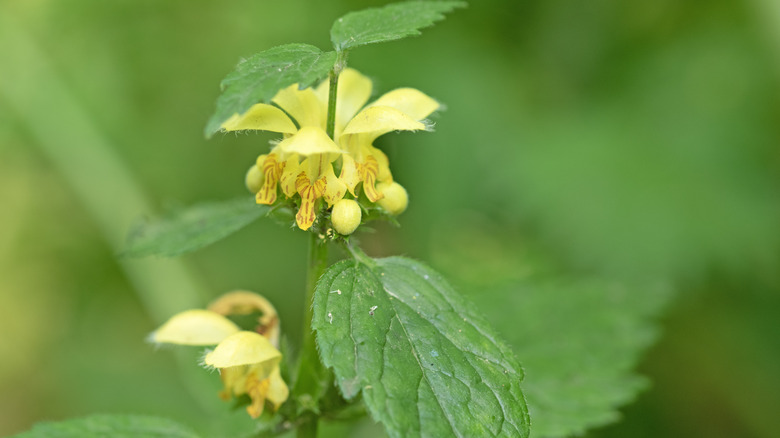Don't Be Fooled By This Pretty Yellow Flower That's An Invasive Weed In Disguise
You, like many gardeners, may welcome a bit of chaos in your garden and appreciate any unexpected plants that "volunteer" to grow in your yard. While in some cases this can lead to an amazing garden full of native wildflowers, you need to keep an eye out for any invasive species that start to grow. As pretty as these plants may be, they can damage ecosystems by outcompeting native species and can completely take over your yard or garden. One plant that isn't worth keeping around — despite its beautiful yellow flowers — is yellow archangel (Lamium galeobdolon).
Yellow archangel, or golden dead nettle, is a member of the mint family, and like many plants in that family, it is an extremely aggressive grower. Hardy in zones 4 through 9, yellow archangel is native to Europe and parts of the Middle East. It can become extremely invasive in the United States, particularly in the western half of the country. If you discover that the pretty, blond-colored flowering plant growing in your yard is actually yellow archangel, your best option is to remove it immediately.
Identifying and removing yellow archangel
The easiest way to identify yellow archangel is by its clusters of tubular yellow flowers that appear in spring. Even when it's not flowering, you can often identify it thanks to its toothed leaves and square stem. In fact, this type of square-shaped stem is often a good way to identify a plant in the mint family. You can find yellow archangel in a variety of places in your yard, from sunny to shady.
Once you've confirmed that your cute garden volunteer is actually yellow archangel, you should begin working to remove the plant. If it is just a single plant or a small patch, you may be able to simply dig or pull it up. Unfortunately, archangel is a perennial and can root at nodes along its stem, so just mowing it or removing the flowers isn't enough to get rid of this persistent plant.
Sheet mulching, also known as the cardboard method of weed killing, is an option for smothering larger patches. If necessary, you can also turn to chemical weed killers. Just be sure to read and follow the labels. Herbicides containing triclopyr or imazapyr often work well against yellow archangel. Once you've finally removed the invasive plants, you can then replace them with more appropriate yellow perennial flowers to enjoy — how about black-eyed susans, sunflowers, or marigolds?

